
Utricularia, commonly and collectively called the bladderworts, is a genus of carnivorous plants consisting of approximately 233 species. They occur in fresh water and wet soil as terrestrial or aquatic species across every continent except Antarctica. Utricularia are cultivated for their flowers, which are often compared with those of snapdragons and orchids, especially amongst carnivorous plant enthusiasts.
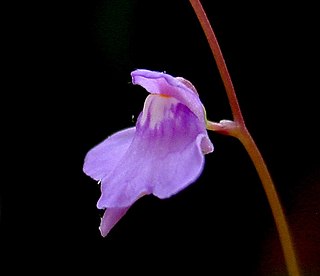
Utricularia amethystina, the Florida purple bladderwort, is a variable species of terrestrial bladderwort native to Bolivia, Brazil, Guyana, Peru, and south-west Florida. The small flowers can be purple, lilac, white, bluish, cream, or bright yellow, and are also highly variable in size and shape.
Common bladderwort is a common name for several plants and may refer to:
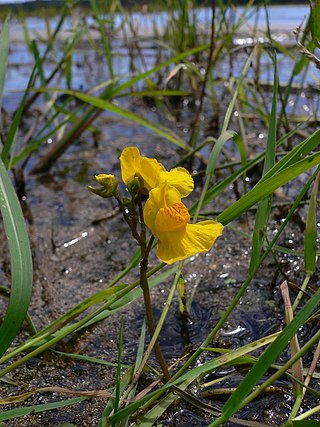
Utricularia australis is a medium-sized, perennial species of aquatic bladderwort. This species has a vast geographic range, being found throughout Europe, in tropical and temperate Asia including China and Japan in the east, Central and Southern Africa, Australia and the North Island of New Zealand. The specific epithet "australis" is Latin for "southern" and reflects the fact that the discovery of this species was made in Australia in 1810.
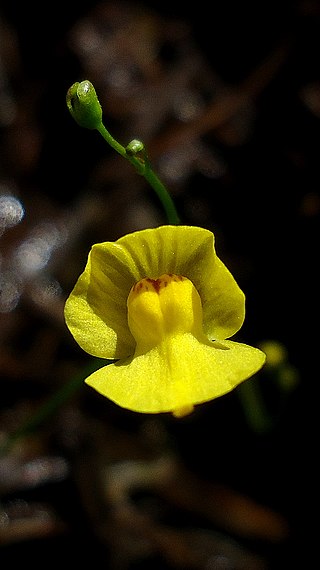
Utricularia gibba, commonly known as the humped bladderwort or floating bladderwort, is a small, mat-forming species of carnivorous aquatic bladderwort. It is found on all continents except Antarctica.

Utricularia resupinata, popularly known as lavender bladderwort or northeastern bladderwort, is a small perennial subaquatic carnivorous plant that belongs to the genus Utricularia. It is native to eastern Canada, the United States, and Central America. This plant species has an interesting etymology, growth pattern, ecology, and research history. As a plant that is threatened or endangered in many of the States where it is found, it is a candidate for sound conservation efforts.

Hibernaculum is the term often applied to a winter bud of certain aquatic plants, such as the bladderworts (Utricularia). The buds are heavier than water, and, being developed at the approach of cold weather, they become detached, sink to the bottom of the pond, and thus survive the winter. In the spring, they enlarge, developing air spaces, rise to the surface, and reproduce their species.

Utricularia aurea, the golden bladderwort, is a medium- to large-sized suspended aquatic carnivorous plant that belongs to the genus Utricularia. It is the most common and widespread suspended aquatic species in Asia. Its native distribution ranges from India to Japan and Australia.
Utricularia floridana, the Florida yellow bladderwort, is a large affixed aquatic carnivorous plant in the bladderwort genus within the bladderwort family). It is a perennial plant that is endemic to southeastern United States.

Utricularia inflata, commonly known as the swollen bladderwort, inflated bladderwort, or large floating bladderwort, is a large suspended aquatic carnivorous plant that belongs to the genus Utricularia. It is a perennial that is native to the southeastern coastal plains of the United States. It has often been confused with U. radiata, which is similar but smaller than U. inflata. Since 1980, U. inflata has been reported to exist in locations beyond its traditional range, such as the Adirondack Mountains in New York, southeastern Massachusetts, and in Washington State. Studies on the populations in the Adirondacks suggest that an introduction of U. inflata to a location where it naturalizes can lead to altered sediment chemistry by reducing the net primary productivity of native species. It is also listed by the state of Washington as a problematic species because of the dense mat-forming habit of this aquatic Utricularia. It is one of the few carnivorous plants that can be invasive.

Utricularia macrorhiza, the common bladderwort, is a perennial suspended aquatic carnivorous plant that belongs to the genus Utricularia. U. macrorhiza is native to North America and eastern temperate Asia.

Utricularia minor, the lesser bladderwort, is a small species of perennial carnivorous plant in the family Lentibulariaceae. It is usually found affixed to the substrate but it can also survive suspended in a body of water. U. minor is a circumboreal species and is found in North America, Asia, and Europe.

Utricularia intermedia, the flatleaf bladderwort or intermediate bladderwort is a small, perennial carnivorous plant that belongs to the genus Utricularia. It is usually found affixed to the substrate but it can also survive suspended in a body of water. U. intermedia is a circumboreal species and is found in North America, Asia, and Europe.
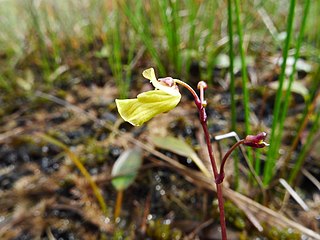
Utricularia ochroleuca, the yellowishwhite bladderwort, pale bladderwort, or cream-flowered bladderwort, is a small, perennial carnivorous plant that belongs to the genus Utricularia. It is usually found affixed to the substrate. U. ochroleuca is a circumboreal species and is found in North America, Asia, and Europe.
Utricularia stygia, the arctic bladderwort or Northern bladderwort, is an affixed aquatic carnivorous plant that belongs to the genus Utricularia. U. stygia is native to northern Europe and North America. This species was originally published by Göran Thor in 1987 but the description was not in Latin and was therefore nomenclaturally invalid. Thor validly published the species a year later. The cited difference that separates U. stygia from U. ochroleuca is the shape of the tiny quadrifid glands inside the bladders, specifically at which angle the "arms" of these glands diverge from one another. Thor, when working on the Utricularia of Sweden noted that this distinction alone allowed for consistent species identification. Both Barry Rice and Peter Taylor have expressed concerns regarding how this method applies to other populations around the world.
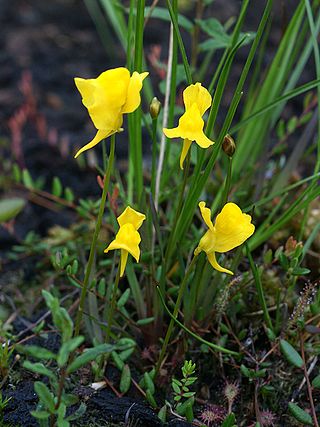
Utricularia cornuta, the horned bladderwort, is a small to medium-sized, probably perennial species of carnivorous plant in the family Lentibulariaceae. It is endemic to North America and can be found in the Bahamas, Cuba, Canada, and the United States. Utricularia cornuta grows as a terrestrial or subaquatic plant in marshes, swamps, and pools in shallow waters, mostly at lower altitudes. It was originally described and published by André Michaux in 1803.

Utricularia uliginosa, the Asian bladderwort, is a small annual carnivorous plant that belongs to the genus Utricularia. It is native to Southeast Asia, Oceania, and Australia. U. uliginosa grows as a terrestrial or subaquatic plant in seasonally flooded shallow pools with sandy soils or on banks and among rocky stream beds at low altitudes. It was originally described by Martin Vahl in 1804.
















